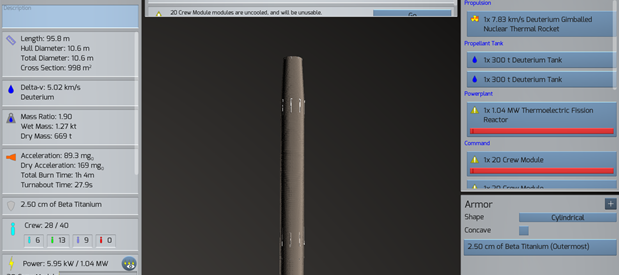At the edge of our solar system, an alien invasion fleet has been identified with the intent to end all of humanity as we know it! It sounds like a prospect right out of science fiction, but the Drake equation has shown that abundant, space-faring life in our galaxy may not be as rare as we are lead to believe; and who ever said they?d be friendly? Even renowned physicist Stephen Hawking forewarned us of engaging in first contact with an advanced alien race, benevolent or otherwise, comparing such an interaction to the introduction of Western settlers to Native Americans in the 15th century. For those who don?t remember their high school history classes, such an introduction did not fare well for the Natives.
Space warfare would be vastly different from what we have seen depicted in Hollywood science fiction masterpieces. TV shows and movies such as Star Trek, Star Wars, Battlestar Galactica, and Babylon 5 display vast battles of hundreds of starships in close proximity, maneuvering through each other and firing glowing energy beams and projectiles towards their enemies. Though beautiful, these CGI space battles which have inspired a generation of science fiction lovers, are far from what you would really see in a battle between opposing space fleets.
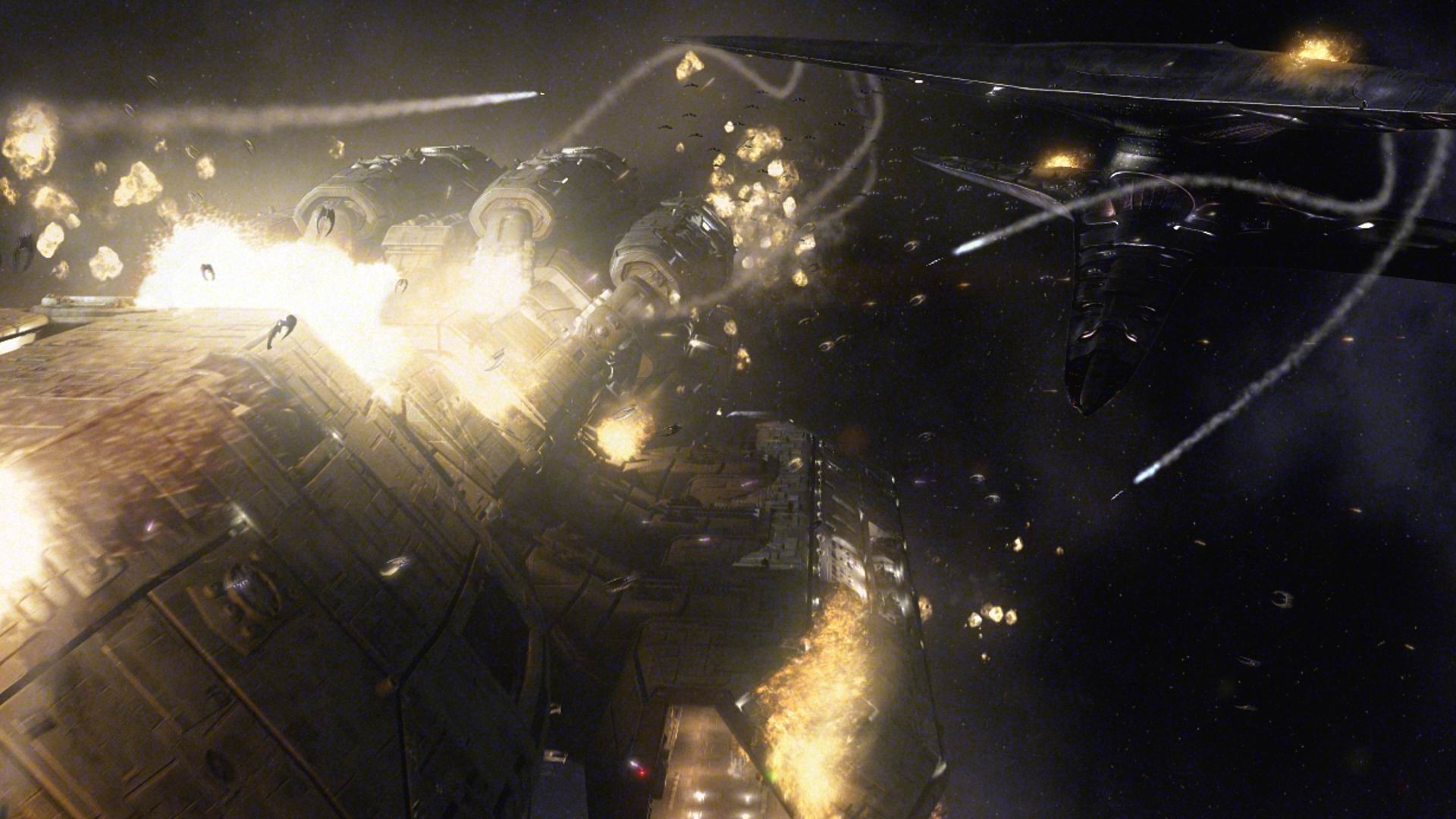 A chaotic, explosive scene from Battlestar Galactica (2004), the source of debatably the greatest sci-fi battles to date.
A chaotic, explosive scene from Battlestar Galactica (2004), the source of debatably the greatest sci-fi battles to date.
If a real space battle were ever to take place, it would have to occur in accordance with the laws of physics and orbital mechanics. Spacecraft designs may not be as sleek as they appear in a JJ Abrams film, and those ship?s weapons may not be nearly as flashy or bright. In a gravitational field, careful plotting of maneuvers needs to be arranged in order for a rendezvous with an enemy craft to even take place. Once in battle, orbital dynamics would not only drive the trajectories of spacecrafts, but of their projectiles as well. Nothing in a space battle would be straightforward.
The Ship
Okay, three lanterns in the steeple; the aliens are coming by space, and they are bent on annihilation. To defend ourselves, we need to design some battleships! In space, you want to use as little material as possible to keep your mass low, and thus your acceleration and delta-v (basically your range), high. Volume wise, the most efficient shape is a sphere, but hold on Death Star lovers, there?s a catch. We are at war, and a sphere (with a circular cross section from all sides) is literally the easiest target to hit. For a balance between low mass and small cross sectional area, a long, slender cylinder does the trick. This cylinder is your armor, and should be composed of very strong metals with high melting points to avoid punctures or ablation.
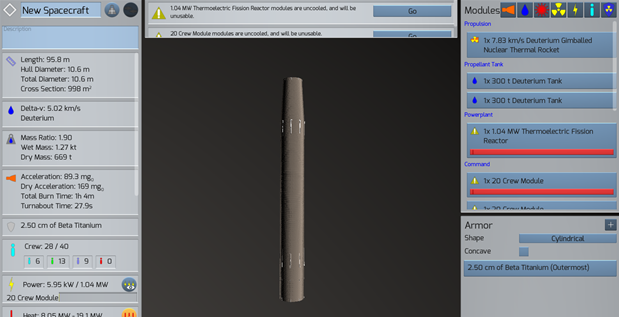 This game I love called ?Children of a Dead Earth? depicts space battles perfectly, for anyone interested. Here is a shell design for a cylindrical spaceship.
This game I love called ?Children of a Dead Earth? depicts space battles perfectly, for anyone interested. Here is a shell design for a cylindrical spaceship.
What do we want to put inside of our cylinder? Possibly the most important subsystem pending the introduction of intelligent AI is human living modules for the crew. We may eventually be able to program AI which is smart enough to strategize space battle plans, but with a several minute communication delay between planets, we will still need to rely on a human crew for this battle.
A space battleship will require a propulsion system with a high delta-v and high acceleration. Conventional rockets have respectable accelerations, but don?t have fast enough exhaust velocities for their delta-v?s to be very high, limiting their range. Modern ion engines and Hall thrusters have noteworthy delta-v potentials, but their accelerations are incredibly slow making them vulnerable in a battle situation. Some form of futuristic propulsion system, such as a fission powered rocket, would be best suited for space combat.
Our ship will also require a lofty power source, far greater than the outputs of solar panels or RTGs. To supply a battleship with enough power to support all of these advanced subsystems, it would probably require a fission reactor cooled by an advanced thermal control system and radiators. Our ship now has the defensive technology to protect and maneuver itself from an enemy assault, but it lacks an offensive powerhouse. We?re going to need some fancy space weaponry!
 Here is an internal view now with added radiators for heat extraction. From the top, we have 2 crew modules, 2 deuterium fuel tanks, a fission reactor, and a deuterium rocket nozzle.
Here is an internal view now with added radiators for heat extraction. From the top, we have 2 crew modules, 2 deuterium fuel tanks, a fission reactor, and a deuterium rocket nozzle.
The Weaponry
Load up the phasers, photon torpedos, and antimatter warheads! Okay, not quite, but we?re going to need to conjure up some weapons quickly because the alien fleet has already reached Saturn and is mining away her rings! Gunpowder is too heavy to bring a useful quantity into space with you, but we do have other options to propel a projectile through space. Magnetic railguns, which use powerful magnetic fields to fire massive metal projectiles out of a cannon at extreme velocities, are an ideal solution. Though it may appear antiquated to use a solid projectile in a space battle, it is important to consider that a 1 kg projectile launched at 5 km/s releases more energy than 13 Toyota Camry?s hitting a solid wall at freeway speeds. If that doesn?t put a dent in your enemy?s spacecraft, it?s probably too heavy for them to move.
 The US Navy?s railgun, which is not in space. It can fire a projectile at over 2 km/s, which is pretty fast.
The US Navy?s railgun, which is not in space. It can fire a projectile at over 2 km/s, which is pretty fast.
Another option for space weaponry is lasers. If you pump enough energy into a laser, and tune the wavelength of that light to match an absorbance wavelength of your opponent?s hull materials, you could theoretically melt a hole right through their ship. It wouldn?t be as glorious as a phaser because the light from a laser would be invisible to an observer as it traveled through the vacuum of space, but it would be perhaps more effective seeing as that an opponent could not dodge a laser blast (there would be no way to see it coming because a laser is light). Other brute force weapons, such as nukes and kinetic missiles, could be used by spaceships at their own risk of carrying those weapons on board.
The Rendezvous
Okay, the alien fleet has stopped to refuel at Jupiter and we don?t want the battle to take place over Earth because of falling debris and such. We have built our own fleet of heavily armored, long cylinders equipped with lasers and railguns powered by fission reactors and we plan to rendezvous with the alien fleet in orbit above Mars. If our fleet simply pointed their noses towards Mars and yelled, ?Mr. Laforge; engage!? we wouldn?t get very far. This is because of orbital dynamics. Nothing in space is stationary. Orbiting the Earth, a fleet of ships already has a velocity in the direction of their orbit, and trying to launch a different direction is like trying to hit someone with a ball out of a moving car; you have to throw the ball early.
Likewise, ships launch to Mars by adding extra velocity to their orbit earlier, so their orbits become elongated like an ellipse. If you apply enough extra velocity to an orbit, the ellipse will become so elongated that it will actually detach from the orbit. Once a ship has detached from Earth?s orbit, it can continue to add velocity to warp it?s orbit around the sun until the farthest side of the ellipse, the aphelion, is at the distance of Mars? orbit. Said ship also has to make sure that Mars will be at the aphelion when it engages in such a maneuver, otherwise it will have nothing to orbit when it gets there. Unlike in science fiction, maneuvering in space only requires a few engine blasts at key moments to arrive at your desired destination. Endlessly firing your thrusters would launch you clear out of the solar system!
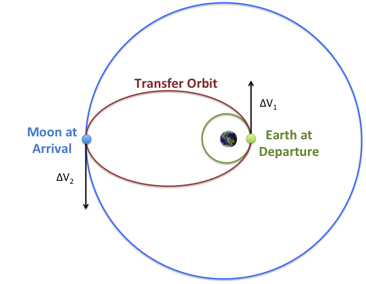 Ships going from the Earth to the Moon actually have to turn on their engines behind the Earth with respect to the moon, so that their orbits elongate to reach the Moon on the other side.
Ships going from the Earth to the Moon actually have to turn on their engines behind the Earth with respect to the moon, so that their orbits elongate to reach the Moon on the other side.
Once at Mars, our fleet need?s to match the alien fleet?s orbit. Unlike sea-faring warship rendezvous, this turns out to be much more challenging than it may appear. It requires knowing your opponent?s exact orbital characteristics, and plotting a course from your current orbit to meet their?s, all while flying in circles around a planet. These calculations would probably be near impossible for a human to complete in a timely manner, and would almost certainly be conducted by computers.
 A small taste of how complex matching orbits can be. The blue line in my fleet?s path, and the red diamond is the enemy fleet.
A small taste of how complex matching orbits can be. The blue line in my fleet?s path, and the red diamond is the enemy fleet.
The Battle
Finally, we have plotted an intercept course, matching the the alien fleet?s orbit. They are within a range where our railguns are accurate enough to hit their ships at a reasonable rate, and our lasers can be concentrated enough to ablate their hulls. Again, however, we cannot fire directly at the alien ships because orbital dynamics would carry our projectiles far off course (except for lasers. Fire away!). All railguns would be forced to adjust to our ship?s velocity, the alien ship?s velocity, and Mars?s gravity in order to land steady hits on the target craft. Firing patterns would appear curved due to the fact that the projectiles hitting the enemy ship would have been fired several seconds ago, when our ship was in a different location. Missiles and nukes could be a little more versatile, carving more complex orbital paths towards their target using fuel and advanced tracking systems.
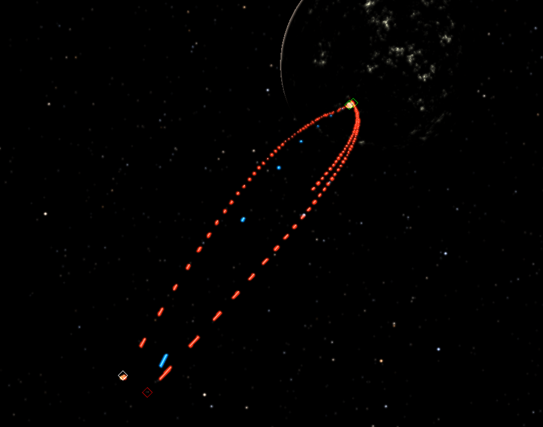 A depiction of how projectile paths appear curved due to different orbital characteristics. Bullets here are made visible by a setting in the game.
A depiction of how projectile paths appear curved due to different orbital characteristics. Bullets here are made visible by a setting in the game.
Contrary to what you would see in a science fiction battle, these vessels would likely never see each other. Aside from the fact that you probably wouldn?t put windows on a spacecraft that is going into battle, your opponent may never have to be within 100 kilometers of you to be defeated. A few key punctures to a radiator could put your opponent?s fission reactor out of business, depriving all power to any weapon or propulsion systems. Likewise, a couple holes poked in a crew module may be irreparable, causing the crew to suffocate and the dead shell of the craft to continue to orbit unperturbed around the planet. Very few circumstances would actually cause the total destruction of a spacecraft in real space warfare.
For a human crew, these battles would most likely be terrifying. With nothing to rely on but sensors, a crew would have no means of assessing the outside situation. Enemy ships, projectiles, and missiles would likely be too small to see before they got into a very close range. Projectiles would pound the outer hull like a deadly hail, each one just as likely as the next to pierce the hull and mark the end of the battle. Rapid decompression of a living module would likely be the culprit of a defeat, or perhaps a meltdown of the fission reactor due to a disruption of the thermal control system. Either way, the end of a space battle would not be a pleasant thing to experience for the losing crew.
 I like to target radiators because they are huge, frail, and everything depends on them. Without radiators, no power systems on a spacecraft can function.
I like to target radiators because they are huge, frail, and everything depends on them. Without radiators, no power systems on a spacecraft can function.
Many battles would end in a stalemate due to the fact that hundreds of rounds of projectiles may still be live from the opposing ship even after their crew is killed or their reactor is nullified. These rounds would continue to impact the winning vessel for several seconds, maybe even minutes, before the stream of bullets runs it?s course to completion. Even if the crew of the victorious ship survives the assault, space is an unforgiving environment to be stranded in. If any of the major systems are in any way damaged, it may be impossible to repair them without access to the resources of Earth.
Conclusion
With all guns trained on the alien invasion fleet, a deadly space battle in orbit around Mars seems inevitable. However, upon communication with the aliens, it turns out that they took a wrong turn at Sirius and ended up in the wrong star system. It?s a good thing too, because contrary to what science fiction has depicted, real space warfare would not be a fun thing to experience. Though I wouldn?t trade the countless beautiful Hollywood science fiction battles for any other depiction of space warfare, real space combat is not something that any future human should be forced to endure. Hopefully, our endeavor towards the stars remains peaceful and exploratory in nature. Oh, and if the alien?s come back looking for their misplaced fuel tanks, we totally don?t have them.
